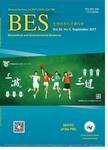Comparison Study on Clinical and Neuropathological Characteristics of Hamsters Inoculated With Scrapie Strain 263K in Different Challenging Pathways
Comparison Study on Clinical and Neuropathological Characteristics of Hamsters Inoculated With Scrapie Strain 263K in Different Challenging Pathways作者机构:NationalInstituteforViralDiseaseControlandPreventionChineseCenterforDiseaseControlandPreventionYingxinRd.100Beijing100052China NationalLaboratoryofMedicalMolecularBiologyInstituteofBasicMedicalScienceChineseAcademyofMedicalSciencesandPekingUnionMedicalCollegeDongDanSanTiao5Beijing100005China SchoolofMedicineXi'anJiao-TongUniversityZhuqueStreet205Xi'an710061ShaanxiChina BSETestLaboratoryBeijingEntry-ExitInspectionandQuarantineBureauBeijing100029China SchoolofMedicinexi'anJiao-TongUniversityZhuqueStreet205Xi'an710061
出 版 物:《Biomedical and Environmental Sciences》 (生物医学与环境科学(英文版))
年 卷 期:2004年第17卷第1期
页 面:65-78页
核心收录:
学科分类:1002[医学-临床医学] 100204[医学-神经病学] 10[医学]
基 金:This work was supported by Chinese National Natural Science Foundation Grants 39928018,30070038 and 30130070, National High-tech Development Project (863 Project) 2001AA215391 EU Project QLRT 2000 01441
主 题:Transmissible spongifonn encephalopathy Scrapie Strain 263K PrP^(Sc) Bioassay Neuropathology Inoculating pathways
摘 要:Objective To understand the infectious characteristics of a hamster-adapted scrapie strain 263K with five different routes of infection including intracerebral (i.e.), intraperitoneal (i.p.), intragastrical (i.g.), intracardiac and intramuscular (i.m.) approaches. Methods Hamsters were infected with crude- or fine-prepared brain extracts. The neuropathological changes, PrPSc deposits, and patterns of PK-resistant PrP were analyzed by HE stain, immunohistochemistry (IHC) assay and Western blot. Reactive gliosis and neuron loss were evaluated by glial fibrillary acidic protein (GFAP) and neuron specific enolase (NSE) specific IHC. Results The animals inoculated in i.m. and Lp. ways with crude PrPSc extracts showed clinical signs at the average incubation of 69.212.8 and 65.5±3.9 days. Inoculation in i.c. and intracardiac ways with fine PrPSc extracts (0.00035 g) caused similar, but relative long incubation of around 90 days. Only one out of eight hamsters challenged in i.g way with low dosage (0.01 g) became ill after a much longer incubation (185 d), while all animals (4/4) with high dosage (0.04 g) developed clinical signs 105 days postinfection. The most remarkable spongiform degeneration and PrPSc deposits were found in brain stem among the five challenge groups generally. The number of GFAP-positive astrocytes increased distinctly in brain stems in all infection groups, while the number of NSE-positive cells decreased significantly in cerebrum, except i.c. group. The patterns of PK-resistant PrP in brains were basically identical among the five infection routes. Conclusion Typical TSE could be induced in hamsters by inoculating strain 263K in the five infection ways. The incubation periods in bioassays depend on infective dosage, administrating pathway and preparation of PrPSc. The neuropathological changes and PrPSc deposits seem to be related with regions and inoculating pathways.



